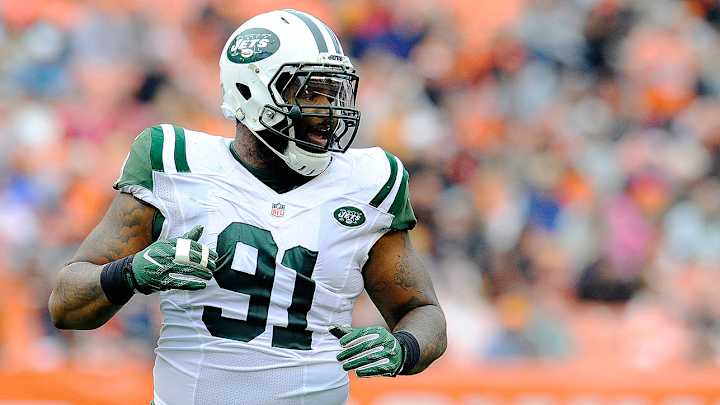Trading Sheldon Richardson Makes the Most Sense for the Jets

It’s easy to understand why Jets fans are angered at the franchise for shipping Sheldon Richardson—one of the few foundational pieces left on a stripped-down roster—to Seattle for what’ll amount to Jermaine Kearse, a low second-round pick and seventh-round positioning. All of that howling would be tough to argue against if it was guaranteed that Richardson would play at his highest level, and if he was a lock to remain in New York after this season.
And that’s how you get to the crux of the Jets/Seahawks blockbuster trade on Friday.
What were the chances of Richardson playing to his potential in 2017 for the Jets? Not probable, given that he hadn’t consistently performed over his first four years, and he wasn’t exactly going to be in an ideal team situation. And for the prospects that he’d sign a long-term deal during or after that season? As I understand it, he and the team had zero talks on any kind of big extension.
It sounds good to say the Jets should’ve just hung on to their most physically gifted player. But the truth is, there was no way to know what they were going to get from Richardson, which is a tough proposition when you’ve spent a couple weeks, as they have in talking with Seattle, learning exactly what you can get for him. It made more sense to Jets GM Mike Maccagnan to deal the inconsistent player than keeping him around. That’s not to mention the fact that the Jets had serious trade talks last year before the deadline to move Richardson, with Dallas among the suitors, and this at least gets them close to what they might’ve gotten for him 10 months ago.
NFL Roster Cuts 2017: Tracking Every Team's Move
That’s part of an overarching issue the team has faced as a result of the Woody Johnson-sponsored gutting of the roster over the last six months. Most, if not all in the organization agreed that, in March, the Jets needed to hit the reset button and go through the pain of separating from a huge crew of veterans. So Darrelle Revis, Nick Mangold, Brandon Marshall, Ryan Fitzpatrick and Ryan Clady were jettisoned.
What happened in early June, with the ouster of David Harris and Eric Decker, was different. The previous moves were about instituting change. These, at least to those there, didn’t feel quite that way—and took a final layer of steady vets off the team.
That, in turn, meant that the team would have to rely on Richardson and the club’s other mercurial defensive lineman, Mo Wilkerson, as team leaders—based on their experience, talent and paychecks. And given the up-and-down history of both, there was plenty of reason to think that, once the losses started mounting, those two (each potentially in their final months as Jets) would go south. That had potential to create a bad situation for Jets coach Todd Bowles, and a poisoned locker room is less than ideal for young, developing players like Leonard Williams, Darron Lee, Marcus Maye and Jamal Adams.
This isn’t to say that Seattle did poorly landing Richardson. The Seahawks needed an interior pass-rush presence, and the team was ecstatic to get Michigan State’s Malik McDowell in the second round of the NFL draft in April. Unfortunately an ATV accident over the summer ruined the big plans they had for the rookie, and it’s hard to imagine a team can do much better on Sept. 1 than to get a talent like Richardson.
The Biggest Winner in the Jets-Seahawks Trade? Sheldon Richardson
Their defensive front, as a result, could be frightening, especially with Richardson given a fresh start, a runway to a big contract, and something to prove.
The Jets don’t have any pressing need to keep their best talent around right now, because they can’t see the top even with a telescope. New York is going be bad, and there was a good chance Richardson was going leave after that, with the potential for things to go sour in between.
And with the risk of all that playing out being very real, this gets pretty simple: the Seahawks gave the Jets a reasonable escape hatch—and they jumped through it.

Albert Breer is a senior writer covering the NFL for Sports Illustrated, delivering the biggest stories and breaking news from across the league. He has been on the NFL beat since 2005 and joined SI in 2016. Breer began his career covering the New England Patriots for the MetroWest Daily News and the Boston Herald from 2005 to '07, then covered the Dallas Cowboys for the Dallas Morning News from 2007 to '08. He worked for The Sporting News from 2008 to '09 before returning to Massachusetts as The Boston Globe's national NFL writer in 2009. From 2010 to 2016, Breer served as a national reporter for NFL Network. In addition to his work at Sports Illustrated, Breer regularly appears on NBC Sports Boston, 98.5 The Sports Hub in Boston, FS1 with Colin Cowherd, The Rich Eisen Show and The Dan Patrick Show. A 2002 graduate of Ohio State, Breer lives near Boston with his wife, a cardiac ICU nurse at Boston Children's Hospital, and their three children.
Follow AlbertBreer